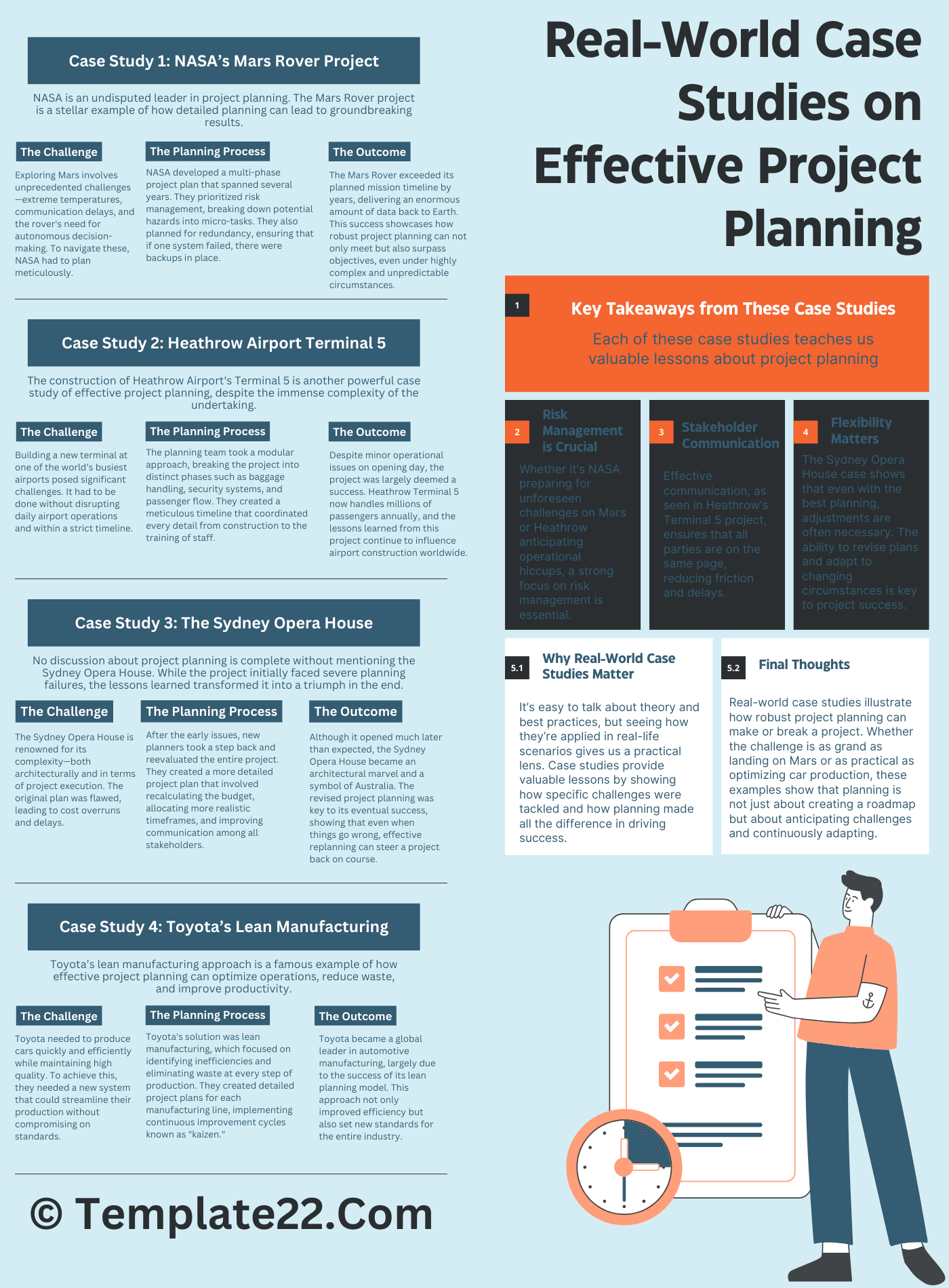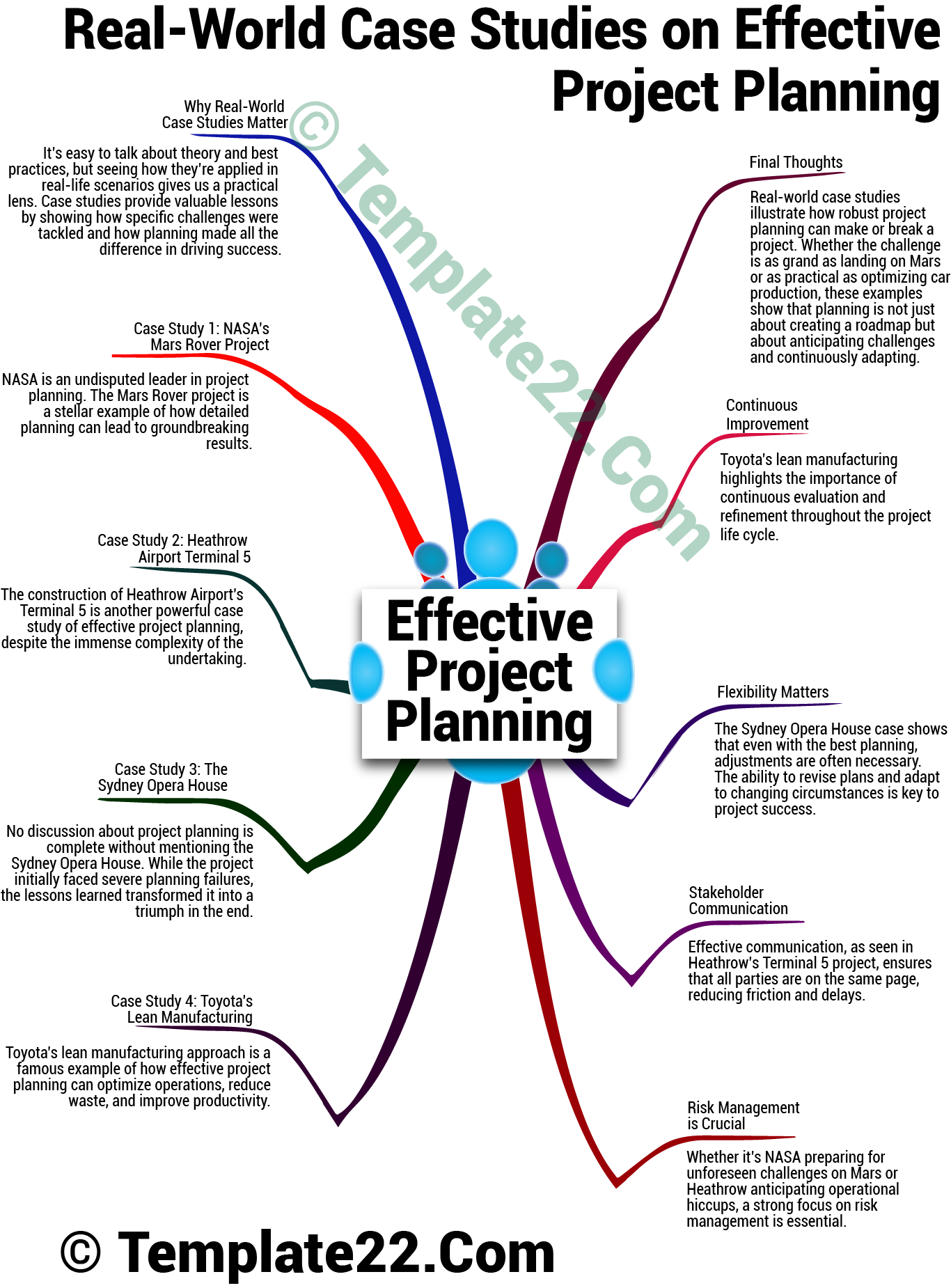 Project planning is the bedrock of any successful project, and nothing illustrates its importance better than real-world examples. In this blog, we’ll dive into several case studies highlighting effective project planning, showing how meticulous preparation and foresight can lead to impressive results.
Project planning is the bedrock of any successful project, and nothing illustrates its importance better than real-world examples. In this blog, we’ll dive into several case studies highlighting effective project planning, showing how meticulous preparation and foresight can lead to impressive results.
Why Real-World Case Studies Matter
It’s easy to talk about theory and best practices, but seeing how they’re applied in real-life scenarios gives us a practical lens. Case studies provide valuable lessons by showing how specific challenges were tackled and how planning made all the difference in driving success.
Case Study 1: NASA’s Mars Rover Project
NASA is an undisputed leader in project planning. The Mars Rover project is a stellar example of how detailed planning can lead to groundbreaking results.
The Challenge
Exploring Mars involves unprecedented challenges—extreme temperatures, communication delays, and the rover’s need for autonomous decision-making. To navigate these, NASA had to plan meticulously.
The Planning Process
NASA developed a multi-phase project plan that spanned several years. They prioritized risk management, breaking down potential hazards into micro-tasks. They also planned for redundancy, ensuring that if one system failed, there were backups in place.
The Outcome
The Mars Rover exceeded its planned mission timeline by years, delivering an enormous amount of data back to Earth. This success showcases how robust project planning can not only meet but also surpass objectives, even under highly complex and unpredictable circumstances.
Case Study 2: Heathrow Airport Terminal 5
The construction of Heathrow Airport’s Terminal 5 is another powerful case study of effective project planning, despite the immense complexity of the undertaking.
CLICK HERE TO DOWNLOAD 300+ PROJECT MANAGEMENT TEMPLATES & DOCUMENTS IN EXCEL
The Challenge
Building a new terminal at one of the world’s busiest airports posed significant challenges. It had to be done without disrupting daily airport operations and within a strict timeline.
The Planning Process
The planning team took a modular approach, breaking the project into distinct phases such as baggage handling, security systems, and passenger flow. They created a meticulous timeline that coordinated every detail from construction to the training of staff. There was also a focus on stakeholder communication, ensuring that all parties, including contractors and government agencies, were aligned.
The Outcome
Despite minor operational issues on opening day, the project was largely deemed a success. Heathrow Terminal 5 now handles millions of passengers annually, and the lessons learned from this project continue to influence airport construction worldwide.
Case Study 3: The Sydney Opera House
No discussion about project planning is complete without mentioning the Sydney Opera House. While the project initially faced severe planning failures, the lessons learned transformed it into a triumph in the end.
The Challenge
The Sydney Opera House is renowned for its complexity—both architecturally and in terms of project execution. The original plan was flawed, leading to cost overruns and delays.
The Revised Planning Process
After the early issues, new planners took a step back and reevaluated the entire project. They created a more detailed project plan that involved recalculating the budget, allocating more realistic timeframes, and improving communication among all stakeholders.
The Outcome
Although it opened much later than expected, the Sydney Opera House became an architectural marvel and a symbol of Australia. The revised project planning was key to its eventual success, showing that even when things go wrong, effective replanning can steer a project back on course.
Case Study 4: Toyota’s Lean Manufacturing
Toyota’s lean manufacturing approach is a famous example of how effective project planning can optimize operations, reduce waste, and improve productivity.
The Challenge
Toyota needed to produce cars quickly and efficiently while maintaining high quality. To achieve this, they needed a new system that could streamline their production without compromising on standards.
The Planning Process
Toyota’s solution was lean manufacturing, which focused on identifying inefficiencies and eliminating waste at every step of production. They created detailed project plans for each manufacturing line, implementing continuous improvement cycles known as “kaizen.”
The Outcome
Toyota became a global leader in automotive manufacturing, largely due to the success of its lean planning model. This approach not only improved efficiency but also set new standards for the entire industry.
Key Takeaways from These Case Studies
Each of these case studies teaches us valuable lessons about project planning:
- Risk Management is Crucial – Whether it’s NASA preparing for unforeseen challenges on Mars or Heathrow anticipating operational hiccups, a strong focus on risk management is essential.
- Stakeholder Communication – Effective communication, as seen in Heathrow’s Terminal 5 project, ensures that all parties are on the same page, reducing friction and delays.
CLICK HERE TO DOWNLOAD 300+ PROJECT MANAGEMENT TEMPLATES & DOCUMENTS IN EXCEL
- Flexibility Matters – The Sydney Opera House case shows that even with the best planning, adjustments are often necessary. The ability to revise plans and adapt to changing circumstances is key to project success.
- Continuous Improvement – Toyota’s lean manufacturing highlights the importance of continuous evaluation and refinement throughout the project life cycle.
Final Thoughts
Effective Project Planning Case Studies illustrate how robust project planning can make or break a project. Whether the challenge is as grand as landing on Mars or as practical as optimizing car production, these examples show that planning is not just about creating a roadmap but about anticipating challenges and continuously adapting. By learning from these successes (and failures), you can fine-tune your project planning strategies and drive better results in your initiatives.
